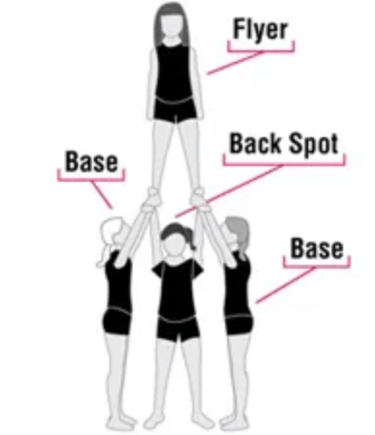Stunting
Positions:
Spotters: This squad member will be close to/assisting the stunt, keeping their eyes completely fixed on the flyer during the stunt along with their arms outstretched or on the flyer. This will help catch the flyer if they fall and also spot problems in the stunt that were missed by others. Their main focus is to ensure the security of the head, neck, and shoulders of the flyer.
Flyers: This is the person going “up” (both in release and non-release stunts). Key technique/form: flyers will begin every stunt with their eyes on a fixed point, looking up since they will soon be up in the air. This helps keep momentum upward and will help in keeping stable. Legs will be “locked out” (straight as possible, engaging leg muscles), with the core engaged and knees straightened to increase stability.
Bases: These are our lifters and supporters for getting our flyer up. Key technique/form: Maintain a straight back throughout ALL stunts and keep feet hip-width apart. With all lifting, the legs should absorb the weight so you don’t strain your back and arms. Once in the stunt, bases need to avoid movement to steady the flyer. Steadiness depends on those holding them, so it is up to the bases to keep engaged and still. Finally, the bases’ eyes must always remain on the flyer so they can catch them if they fall.
Quick note: Weight, height, and/or size of individuals are not the main deciding factor when it comes to deciding positions. Flexibility, core strength, arm and leg strength, and how you hold yourself are much greater indicators of who is assigned to do what.
Please take a minute to watch these great stunting basics videos:
Stunting is fairly new to flags so it’s crucial to remain knowledgeable in this fun and tricky area of dance if we want to incorporate it in our routines.
Whenever we are practicing a stunt, the parts of the team that aren’t participating will remain COMPLETELY SILENT to ensure proper communication and safety between the stunting group and the coach.





